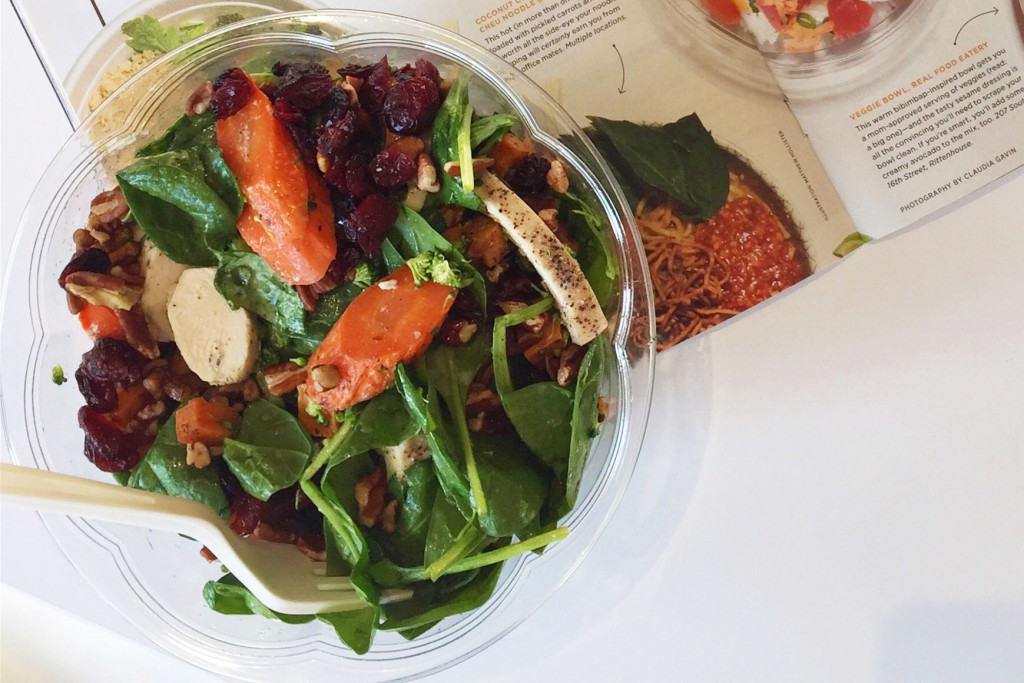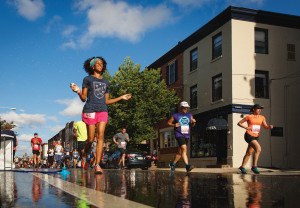The Healthiest and Worst Things to Eat at Honeygrow
Including an 820-calorie salad.

Honeygrow salad photograph by Caroline Cunningham.
Looking for a healthy lunch? Philly’s fresh salad and stir-fry eatery Honeygrow is a great place to start — but that doesn’t mean the menu is 100-percent nutritional sunshine and rainbows. It’s totally possible to use up your cheat meal at Honeygrow — especially because, like many restaurants, some of the dishes are loaded with sodium and calories. To put it in perspective: a Big Mac has 540 calories, and some of the bowls here top 800 calories.
To help you sort through the good and the not-so-good, we asked registered dietitian Amy von Sydow Green to help us identify the healthiest and least-healthy dishes on Honeygrow’s menu. Here are her selections.
Overall Healthiest: White Bean Tuna Salad
Nutrition facts: 500 calories, 33g fat, 4.5g saturated fat, 620mg sodium, 26g carbohydrates, 7g fiber, 7g sugar, 27g protein
Why’s it good? “This salad contains a sturdy 27 grams of protein, while still being in a very reasonable calorie range (500) for a lunch or dinner,” says Green. “The tuna fish is a great source of healthy omega-3 fats. The fiber content is high.”
Overall Least Healthy: Sweet Soy Five Spice Stir-Fry
Nutrition facts: 660 calories, 27g fat, 4.5g saturated fat, 1780mg sodium, 76g carbohydrate, 10g fiber, 26g sugar, 32g protein
Why’s it bad? “This stir-fry packs in a huge 1780 mg of sodium! The American Heart Association recommends no more than 2300 milligrams of sodium per day, and ideally they would like people to stay under 1500 milligrams per day. Aiming for a lower sodium intake can help you prevent high blood pressure,” says Green.
“The amount of sugar in this dish is also very high: 26 grams, which equals about six teaspoons,” says Green. “Compared to most of the other dishes on the Honeygrow menu, this dish is relatively low in vegetables (as a rule of thumb you want to make half of your plate veggies), and it contains only green beans and red onion.”
Healthiest Salad: Winter Kale Salad
Nutrition facts: 450 calories, 38g fat, 8g saturated fat, 530mg sodium, 20g carbohydrate, 7g fiber, 8g sugar, 13g protein
Why’s it good? “The White Bean Tuna Salad wins the prize for healthiest salad, but the Winter Kale Salad is a close second,” says Green. “The Winter Kale Salad packs in a super-high amount of micronutrients, with the kale providing for example multiple vitamins: A, C, K, and folate, important for many processes in the body, including vision and the immune system. This is a really nice vegetarian option due to the mushrooms: they provide a nice source of minerals, but also certain B vitamins, that sometimes are hard for people that don’t eat meat to get enough of.”
Pro tip: “If you need the salad to be more filling, boost the protein content by adding roasted spicy tofu,” says Green.
Least Healthy Salad: Cobb Salad
Nutrition facts: 820 calories, 60g fat, 13g saturated fat, 1240mg sodium, 25g carbohydrate, 12g fiber, 11g sugar, 49g protein
Why’s it bad? “This salad is high in saturated fat due to the bacon and blue cheese,” says Green. “Intake of processed meats such as bacon should be minimized to protect your health. At 820 calories, the portion size of this salad is too large for many adults, although someone who is very active may need all that energy!”
Healthiest Warm Bowl: Sesame Garlic
Nutrition facts: 800 calories, 27g fat, 4.5 g saturated fat, 1860 mg sodium, 94g carbohydrate, 5g fiber, 8g sugar, 45g protein
Why’s it good? “This stir-fry is the second lowest in sugar of the stir-fry options, and even though it’s high in calories, the protein content is also really high, and it would be a good option for a really hungry person,” says Green. “The whole-wheat noodles or brown rice are my two favorite stir-fry carbs, both of them containing whole grains. Mushrooms, broccoli, and scallions provide a nice variety of vegetables. Broccoli is a great source of vitamin C.”
Least Healthy Warm Bowl: Sweet Soy Five Spice Stir-Fry
Nutrition facts: 660 calories, 27g fat, 4.5g saturated fat, 1780mg sodium, 76g carbohydrate, 10g fiber, 26g sugar, 32g protein
Why’s it bad? See above. “For all of the stir-frys, I would recommend asking for half of the amount of the carbohydrate, and go with the brown rice or the whole wheat noodles,” says Green. “The ratio of carbohydrate to veggies is high! Ask for extra vegetables, instead, in order to balance out your meal.”
Like what you’re reading? Stay in touch with Be Well Philly—here’s how:
- Like Be Well Philly on Facebook
- Follow Be Well Philly on Twitter
- Follow Be Well Philly on Instagram
- Follow Be Well Philly on Pinterest
- Get the Be Well Philly Newsletter


